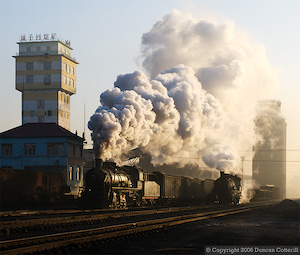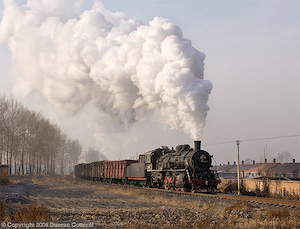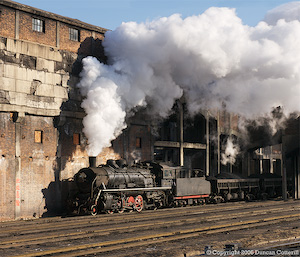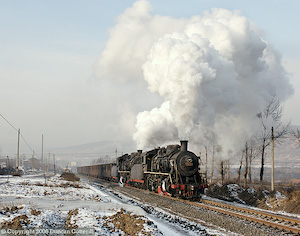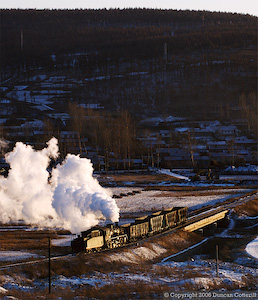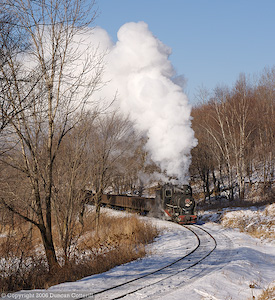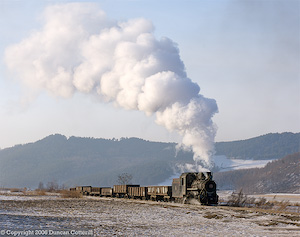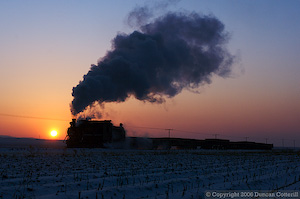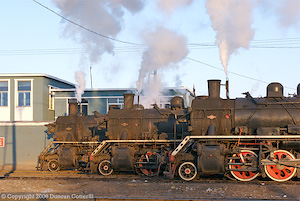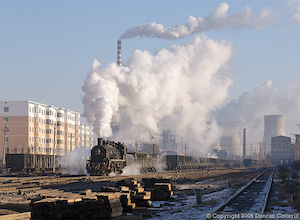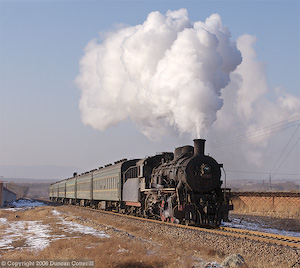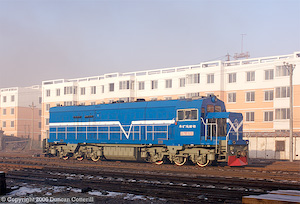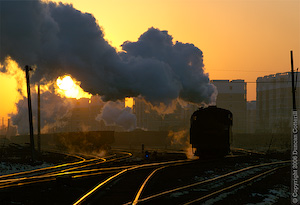North East Industrials
20 November - 03 December 2006
Report by Duncan Cotterill
Introduction
This report covers a short trip by Peter Breeze and myself to the north-east of China in November 2006. We visited the Jixi, Huanan and Fuxin industrial systems. Arrangements were made through Sun Xiaolan of CLSLPA and Xiaolan accompanied us as a guide throughout.
London – Paris – Beijing – Harbin – Jixi
(20-22 November 2006)The outward trip went smoothly enough with all the connections working as planned but it was a long and tedious journey to Jixi. We flew with Air France from the UK to Paris then on to Beijing, arriving at 08:55 on the morning of the 21st. At Beijing we met up with Xiaolan and flew up to Harbin on CZ6220 at 12:10, a journey made far more interesting by the rigmarole necessary to get my bottle of duty-free whisky onto the plane – as hold baggage in its own special box. The final leg to Jixi was very civilised, travelling in soft sleeper on train N27. The motive power wasn’t checked out but I assume it was one of Sankeshu’s many DF4DKs. Arrival at Jixi was at 04:37 on the morning of 22 November.
Jixi Mining Railways
(22-23 November 2006)Jixi continues to be one of China’s premier steam locations with five colliery systems located around the city. Although the first diesels are expected soon, none have arrived yet and 100% steam operation continues. We visited four of the five systems during our stay in the area. For more details see my February 2005 and March 2006 reports.
Traffic levels did seem to be down on previous visits and we got the impression that this was caused by a shortage of CNR wagons. The first morning at Hengshan produced a procession of light engine movements up the hill to Zhongxin but only one train of empties was seen. SY 1018, previously seen at Chengzihe, was working on the Hengshan system.
In the afternoon we visited Lishu and found workings to Pinggang and Qikeng. However the Pinggang train was only two wagons instead of the 40+ we had seen on our last visit. The Qikeng train was the usual rake of wooden bodied internal hoppers. Another 2 wagon train operated to the brickworks beside the Qikeng branch.
The following morning’s shift change at Chengzihe Dongchang saw no less than eight locos visit the yard between 07:00 and 09:00 but only internal trains of spoil tippers and coal hoppers were seen. The usual long trains of CNR wagons to or from the eastern pits were missing. The afternoon session at Didao produced by far the best pictures I’ve ever got there but, once again, all the workings were of internal tippers and coal wagons.
The weather was generally good during our stay in Jixi clear skies, apart from a short period on the first morning, and good visibility. There was a little snow on the ground in places but other spots were completely clear.
All the locos noted below were in use.
Chengzihe : SY 0237, 0590, 0733, 1058, 1344, 1351, 1437, 1544
Didao : 0407, 0950, 1213, 1446
Hengshan : SY 0341, 0746, 1018, 1095, 1340
Lishu : SY 0477, 0951
Jixi to Huanan
(23 November 2006)From Jixi we travelled north by road to Huanan, taking less than two hours from Didao to the hotel in the centre of Huanan. A DF8 was seen on a southbound freight south of Boli.
Huanan Forestry Railway
(24-27 November 2006)This is a gem of a line but it has had a difficult year with many visitors reporting little or no activity long after the traditional Spring Festival break. Fortunately, things appeared to return to normal by late summer. When we arrived, the railway was working to the usual 4-hour cycle with returning trains being banked from Lixin to the summit as expected (see my September 2004 and September 2005 reports for further details of the traffic patterns). The weather was excellent at first with clear blue skies and just enough snow to cover the ground without impeding movement. Clearly this was too good to last. By 08:00 on the second day the sky had clouded over and we didn’t see the sun again until the morning of the fourth day.
By then 011 and 041 had both failed and there were only two serviceable engines available. As a result the service was reduced to one return working every eight hours or so, effectively meaning only one train each way a day between sunrise and sunset. To make matters worse the only train from Lixin was smoked out and we got our first shot of the day a couple of minutes before sunset. By the time we got back to Huanan, a third loco was in steam outside the shed so normal service was probably resumed shortly afterwards.
Unfortunately it seems that foreign visitors to this line are now subject to a charge of 100 RMB each. This is collected by a forestry official based at the Lixin end of Tuoyaozi village and appears to be legitimate, although blatantly racist and highly undesirable. We insisted that he produce official proof that he was entitled to collect the money before paying and receipts were issued. The 100 RMB fee was a one-off charge for as long as we wanted to stay and although we were around for 4 days we weren’t bothered again. So how did he know we were there? I can only assume that our presence was reported by a track worker who got his mobile phone out as soon as he saw us. Individuals may be able to sneak past the gripper but it’s not so easy with a group and vehicle.
All the locos noted below were in use.
Huanan : 011, 041, 044, 168
Huanan to Jixi
(27 November 2006)After four days at Huanan we returned to Jixi by road, arriving in the town centre less than two hours after leaving Huanan.
Jixi Mining Railways
(28-29 November 2006)By the time we returned from Huanan the Chengzihe system was getting plenty of wagons from CNR and was back to its usual busy self. Hengshan was still very quiet with only one train of empties seen climbing the bank from Xinhengshan on the morning of 29 November. There were reports of a bad accident at the Yuanhua mine near Hengshan but it appeared to be a small privately owned mine and not one of the rail-connected pits. At no time did we feel that our presence in the area was unwelcome and the loco crews were as friendly as always.
Jixi to Fuxin
(29-30 November 2006)We left Jixi by road around 10:00 and travelled to Mudanjiang via Xiachengzi and Modaoshi, a superbly scenic route, if a little longer than the direct road. From Mudanjiang we took train 1452/1449 to Jinzhou Nan. Mudanjiang depot contained the expected collection of DF4B DF4D and DF8 locos. The DF4C seen on an unidentified southbound or westbound passenger wasn’t expected though – could it have been a Shenyang Bureau loco working back to Tumen? The DF8Bs seen here in early 2005 must have been on test and don’t seem to have become a permanent feature of the Mudanjiang rail scene. DF4DK 3251 was in charge of our train for the first leg to Harbin where an unidentified electric took over for the remainder of the journey. The soft sleepers were too comfortable to leave at Harbin to check out the loco change. We continued by road to Fuxin, arriving about 2 hours after leaving Jinzhou.
Fuxin Mining Railway
(30 November – 02 December 2006)This was our first visit to Fuxin and we weren’t sure what to expect. Fuxin had a reputation for poor atmospheric conditions and the mining industry there was in serious decline. It had also been a long time since anyone reported from the area and a lot could have happened in the meantime. To say we were pleasantly surprised would be an understatement.
Fuxin isn’t in the same league as Jixi or Zhalainuoer for good photographic potential but there are a number of pleasant locations and the level of steam activity is still quite high despite the rapid run down of mining in the area. The weather was surprisingly good with clear bright sunshine and good visibility for most of our stay. The town of Fuxin appears to be changing rapidly with many new blocks of flats under construction and the wholesale demolition of the hutongs mentioned in previous reports.
The passenger service was much reduced from that reported by previous visitors. There were only two trains in each direction over the full length of the line from Xinqiu to Wangying. Times at Wulong were 06:05 and 13:55 westbound and 09:43 and 17:57 eastbound. The trains were formed of six green coaches (YZ22s?) and SY 0126 was the regular power during our visit. There was also a 2-coach passenger from the Xinqiu direction that arrived at Wulong around 07:15 and terminated. SY 1396 was the regular loco for this working and ran round after arrival at Wulong then took the stock back to the sidings. We were unable to find a timetable anywhere so there may have been more trains during the hours of darkness but the 07:15, 09:43 and 13:55 trains were the only daytime workings we saw.
Railway staff told us that the opencast mine at Fuxin had produced very little coal for the last six months and what it did produce was now taken to the washery by road vehicles. In spite of this there was still a lot of activity around Wulong with coal coming in from various deep mines on the system and going to the power stations at Fuxin and Miapu. We even saw one train of coal coming in from CNR so it’s likely that Fuxin no longer produces enough to supply the online power stations, let alone export any. We also saw a number of spoil trains, presumably coming from the washery but their precise source wasn’t determined. As reported by previous visitors, traffic was busiest between 09:00 and 11:00 and then picked up again after 13:00.
The old colliery main line west of Minzu to Dongliang had been reported closed but this was not the case. Although the passenger service had ceased there was still some freight traffic. We saw an SY make a couple of trips down the line to fetch tipper wagons while we were waiting on the branch for the afternoon passenger to Wangying. A new mine shaft was being built beside the Wangying branch about 1 km from Minzu but it wasn’t clear whether it would be rail connected or not.
The electrification in the vicinity of Wulong and the yard to the north was all out of use with the contact wires removed. On the line around the rim of the pit and further north, around Taiping, the overhead was intact but we didn’t see any electric locos using it, only steam. We didn’t see a single electric loco that appeared capable of moving, let alone actually in use although there were many dumped examples around. It is possible that electric working has ceased altogether but this can’t be confirmed as we didn’t go out of our way to check the whole electrified system.
The steam situation was much healthier with no less than 14 SYs seen in use including SY 1818 (really SY 1414), which was being run in after overhaul. The early morning congregation of locos just north of Wulong station was still worth seeing with six or seven locos present between 07:30 and 08:30 every day. The Wulong based engines all seemed to face southwest while those based at the stabling point near Taiping faced northeast. It wasn’t all good news though. Fuxin now has a diesel, DF5D 0066 built at Dalian in 2006, which was being used interchangeably with the SYs on trains around Wulong. The loco was lettered “Fuxin Mine Transport Division” (a very rough translation) so there’s no doubt that it is permanently based here. No doubt more will follow but how many and when?
All the locos noted below were in use. In spite of frequent visits in the past, few builders details seem to have been reported for the Fuxin locos but we managed to record them for most of the locos we saw. There were no real surprises and SY 1818's plates are consistent with it really being SY 1414. See the filmstrip for details.
Fuxin Locos : SY 0126, 0540, 0785, 0850, 0911, 0941, 0988, 0989, 1210, 1319, 1378, 1395, 1396, 1414. DF5D 0066
The following locos were dumped. Letters in brackets refer to their locations on Ian Juden's map in CRJ 124.
South Depot (M) : SY 0127, 0576, JF 508
Taiping Stabling Point (g): SY 0541, YJ 403
Track Depot N of Taiping (f) : SY 0002, 0035, 0205, 1089, JF 2195
We didn’t visit the works, spend much time around Taiping, investigate the big hole or travel to the outlying pits at Aiyouying or Qinghemen so there were probably more locos in use than those listed here. The three dumped locos of greatest historic interest, JF 508, SY 0002 and YJ 403 were all in very bad shape and devoid of plates. Apart from one SY, none of the dumped engines still had its plates attached.
Main line freight around Fuxin was hauled by DF4B and DF4C with most passengers worked by orange DF4Bs. The exception was train 4217/4219 from Dandong to Yebaishou, which was DF11 hauled both times we saw it.
Fuxin – Jinzhou - Beijing – London
(02 – 03 December 2006)We left Fuxin after the morning passenger on 2 December and travelled by road to Jinzhou where we caught train 2590 at 12:58 to Beijing. Shenyang’s DF11 0141 provided the power to Shanhaiguan. The old main line either side of Jinzhou was in the course of being electrified with poles erected along much of the route but no wires as of yet. In several places the railway had been realigned or was in the course of being realigned. Even though the new high-speed line from Shenyang to Shanhaiguan has been in use for several years, the original route clearly has a long term future.
Jinzhou pilots were DF5 and freights hauled by DF4B, DF4C and DF8B were seen east of Shanhaiguan. There seemed to be more DF4C and less DF8B hauled freights than on previous visits but the stabling point east of Shanhaiguan was full of Shenyang Bureau DF8Bs. Passengers seen were DF11 hauled and a westbound mail train had a DF4D.
At Shanhaiguan an electric took over for the run to Beijing via Fengrun. The loco on our train wasn’t identified but the balancing working, 2589, was seen arriving at Shanhaiguan behind an SS8. A number of SS9Gs and DF11s were seen on Shanhaiguan shed. Freights seen west of Shanhaiguan were mainly SS1 or DF8B hauled.
After a night in Beijing we flew to Amsterdam then back to the UK with KLM, an airline I hadn’t used for around 10 years and hope not to use again for a long time.
Conclusions
Where’s everybody gone? During our two weeks in China we only saw one small group of foreign gricers, Dave Kitching and a couple of friends at Hengshan on our first morning. There’s still plenty of steam to see and photograph in post-Jingpeng China but it appears that many people have lost interest already – prematurely in my opinion.
Jixi is the sort of place that you can keep on going back to. With five active systems and numerous good locations to choose from, there’s no shortage of variety and Chengzihe at sunrise usually produces a few treats. China is changing very rapidly and new photo locations are continually emerging while others are eliminated. Since our previous visit in March, a section of the bank out of Hengshan has been cleared allowing photos that weren’t possible before. The first diesels are forecast to arrive in early 2007 but it will take a lot of new locos to have a serious impact on the steam operations here. It also remains to be seen how and where the diesels will be used. If the aim is to eliminate steam working over CNR metals then they could go to Donghai or Lishu. If maximising usage is a priority then Hengshan or Chengzihe are more likely destinations. Whatever happens there should still be plenty of SYs to photograph for a few years yet.
Photographing the Huanan narrow gauge line in the snow was a high priority following our failed attempt in March 2006. Despite a couple of days of poor weather and a lack of trains on the last day, we did get a few really good shots in winter conditions. It’s anyone’s guess how long this unique operation can continue – go there while you can.
Fuxin had failed to make the grade when planning previous visits to China. The combination of poor visibility, lack of scenery and electrification had always counted against it but this time we decided to have a couple of days there on the way back to Beijing. It was a good decision as we were favoured with generally good weather and activity levels were reasonably high, although obviously well down on previous years. The locations we found were a bit less than inspiring but not unpleasant. The opencast mine and its once extensive electric system seem to be on their last legs and the electric locos may already be history. The steam operations appear to have a longer term future serving the power stations and deep mines and dieselisation, rather than closure, is the main threat. While I wouldn’t say Fuxin is worth going a long way to visit, it’s certainly worth spending a couple of days there if you’re in the area.
This wasn’t the easiest trip I’ve ever done but it was very enjoyable with good company and excellent food providing adequate compensation on the few occasions when the weather or the gricing didn’t go to plan. When I started visiting China in the mid 1980s, the food was terrible and two weeks chasing steam was a very good way to lose weight. Now the opposite is true with superb restaurants in every medium sized town and good wholesome food available everywhere, it’s difficult to avoid putting on weight. The days of leaving home with a suitcase full of Mars bars are long gone.
Despite the dieselisation of the JiTong Railway, the closure of the forestry systems and the loss of much industrial steam over recent years, Chinese steam isn’t finished yet. How much longer this will be true is debatable and anyone contemplating a trip should go as soon as possible while there are still some excellent 100% steam locations left. You won’t regret it.
